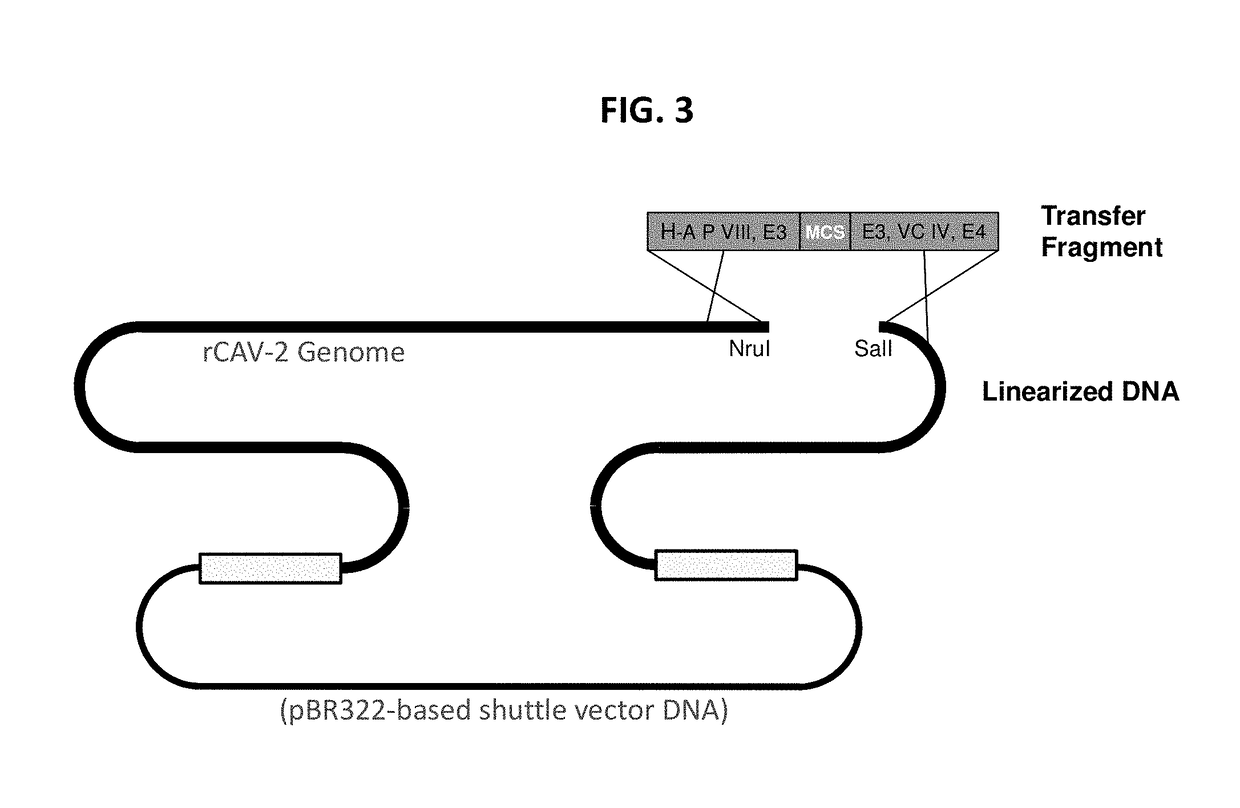Canine adenovirus vectors
a technology of canine adenovirus and vector, which is applied in the field of vector vaccines, can solve the problems of inability to measure protein expression in infected cells, inability to conclude robust expression of transgene in individual cells, and the usefulness of the cmv-driven expression cassette in the cadv2 vector, and achieve the effect of facilitating transgene expression
- Summary
- Abstract
- Description
- Claims
- Application Information
AI Technical Summary
Benefits of technology
Problems solved by technology
Method used
Image
Examples
example 1
CAdV Virus Isolation
[0195]The CAdV2 virus was originally isolated from a throat swab from a dog with laryngotracheitis and was obtained as the first passage in American Type Culture Collection (ATCC) MDCK cell line CCL-34. The virus was passed 8 times after acquisition, and the 8th passage was aliquoted and designated as the Master Seed Virus. The stock CAdV-2 Master Seed Virus was produced at Boehringer Ingelheim Vetmedica, Inc. under the reference CAdV-2, MSV Lot #001-dil, F: 11-24-98. The stock CAdV-2 Master Seed is closely related to the Toronto strain (Genbank Accession Number U77082.1). CAdV-2 is commercially available from Boehringer Ingelheim Vetmedica, Inc. as a canine vaccine.
[0196]The infectious clone DNA is the entire CAdV-2 genome cloned into the pBR322 low copy E. coli shuttle vector. A homologous recombination approach (Kremer, E. J., et al., Canine adenovirus vectors: an alternative for adenovirus-mediated gene transfer. J Virol, 2000. 74(1): p. 505-12.) was employed...
example 2
Generation of E3-Deleted-Insertion CADV Clones
[0198]CAdV-2 has been successfully utilized as a vectored viral vaccine for animals. The E3 domain of CAdV-2 is known to be non-essential (none of the E3 open reading frames (ORFs) is required for viral replication in tissue culture (Fisher et al. 2002) and present a logical target for the insertion of heterologous DNAs.
[0199]Examples of efficacious CAdV-2-based vaccines wherein transgenes are localized to the E3 domain include canine distemper virus (Fisher et al. 2002), feline panleukopenia virus (Yang et al. 2008), and rabies for cats (Hu et al., 2007), dogs (Hu et al., 2006) mice (Li et al., 2006), raccoons, swine (Lui et al., 2008), skunks (Henderson et al., 2009) and sheep (Bouet-Cararo et al., 2011).
[0200]FIG. 2 is a schematic of the organization of the E3 region of CAdV-2. The 4146 bp NruI (bp 23932) / SalI (bp 28078) restriction endonuclease fragment is illustrated with open reading frames (ORFs) shown as the H-A Protein VIII, ORF...
example 3
Homologous Recombination for Generation of RCADV-2 Infectious Clone DNAS
[0203]Homologous recombination in Rec+ BJ5183 E. coli between linearized CAdV-2 infectious clone DNAs and E3-targeting CAdV-2 transfer plasmids / fragments, based on methods described in papers by Chartier et al. (1996) and Kremer et al. (2000), was employed for the generation of rCAdV-2 with transgene expression cassettes localized to the E3 domain. As illustrated in FIG. 3, an infectious clone that contains a unique restriction site in the E3 domain recombines with a transfer fragment containing ˜500 bp of CAdV-2 flanking DNA both 5′and 3′to transgene expression cassettes to both a) target the transgene expression cassette to the E3 region and b) effectively delete select portions of E3.
[0204]DNA was isolated from expanded BJ5183 clones identified using a transgene-specific PCR screen, and these DNAs were resolved by agarose gel electrophoresis to verify their migration at or >23.1 Kb (successful HR results in D...
PUM
| Property | Measurement | Unit |
|---|---|---|
| temperature | aaaaa | aaaaa |
| temperature | aaaaa | aaaaa |
| rectal temperature | aaaaa | aaaaa |
Abstract
Description
Claims
Application Information
 Login to View More
Login to View More - R&D
- Intellectual Property
- Life Sciences
- Materials
- Tech Scout
- Unparalleled Data Quality
- Higher Quality Content
- 60% Fewer Hallucinations
Browse by: Latest US Patents, China's latest patents, Technical Efficacy Thesaurus, Application Domain, Technology Topic, Popular Technical Reports.
© 2025 PatSnap. All rights reserved.Legal|Privacy policy|Modern Slavery Act Transparency Statement|Sitemap|About US| Contact US: help@patsnap.com



